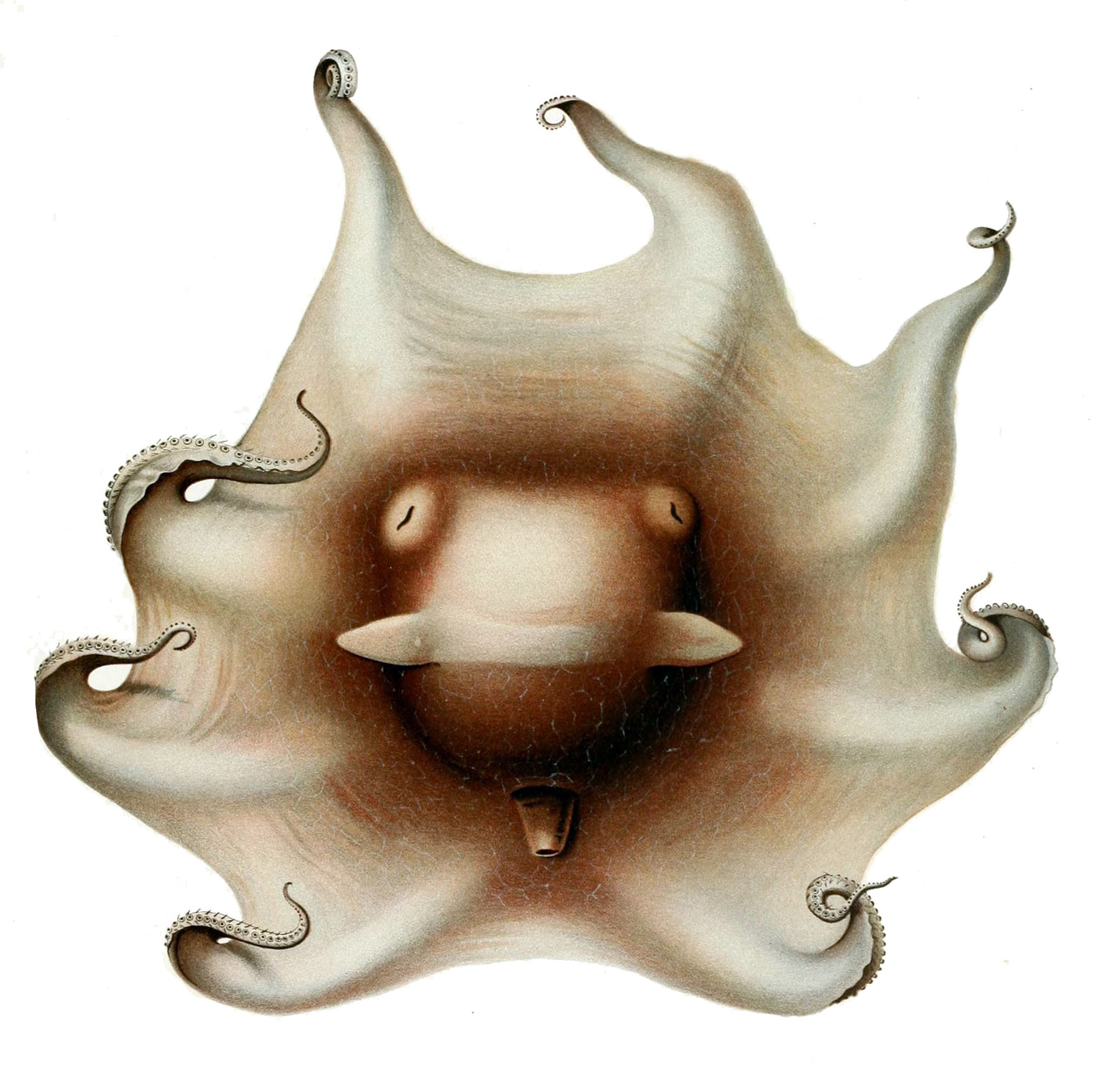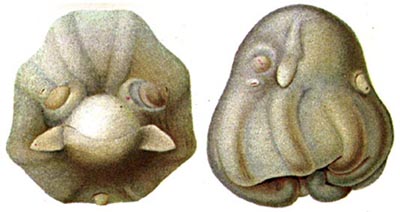Opisthoteuthidae on:
[Wikipedia]
[Google]
[Amazon]

 Umbrella octopuses (
Umbrella octopuses (
When resting at the floor, the octopus's behavior falls into one of two tactics: bottom-resting or flat-spreading. Bottom-resting is when the octopus is resting near the floor. It will erect its mantle, curve the outer edges of its tentacles inwards to have them be the only part making contact with the floor. The fins are extended out parallel to the bottom to maintain balance. When flat-spreading they spread their tentacles and web, so it is parallel to the bottom and they keep the edges of their tentacles curved inwards. Their heads will point backwards at a small angle and their fins will be used for stabilization.
Tree of Life website gives information about the classification of cephalopod groups
{{Taxonbar, from=Q2207194 Octopuses

 Umbrella octopuses (
Umbrella octopuses (family
Family (from la, familia) is a Social group, group of people related either by consanguinity (by recognized birth) or Affinity (law), affinity (by marriage or other relationship). The purpose of the family is to maintain the well-being of its ...
Opisthoteuthidae) are a group of pelagic
The pelagic zone consists of the water column of the open ocean, and can be further divided into regions by depth (as illustrated on the right). The word ''pelagic'' is derived . The pelagic zone can be thought of as an imaginary cylinder or wa ...
octopus
An octopus ( : octopuses or octopodes, see below for variants) is a soft-bodied, eight- limbed mollusc of the order Octopoda (, ). The order consists of some 300 species and is grouped within the class Cephalopoda with squids, cuttle ...
es. Umbrella octopuses are characterized by a web of skin between the tentacles, causing them to somewhat resemble an opened umbrella when the tentacles are spread.
Description
Opisthoteuthidae are a group of octopuses characterized by a web of skin in between their tentacles. They have a U or W shaped shell that holds the mantle and connects to their tentacles at the bottom. This structure makes the umbrella octopus resemble an umbrella when they spread their tentacles/web out. The structure of the umbrella octopus has the oral surface below the mantle of the octopuses and the web with their tentacles surround the bottom of the mantle. Their outer skin has a very delicate consistency that results in white spots appearing on their skin when damaged. Opisthoteuthidae fall into the cirrate octopod group, meaning they have fins. Although opisthoteuthidae are categorized as cirrates, unlike the other cirrates, they do not have an intermediate web; rather, they use the web in between their tentacles to mimic the intermediate web that other cirrates have. Lacking an intermediate web is what causes the indentations in the outer edge of their tentacles that make them look like an umbrella.Behavior
Defense mechanisms
Opisthoteuthidae lack an intermediate web but they mimic the defensive mechanism of ballooning by extending the web between their tentacles as much as possible and curving the outer edges of their arms inwards in order to have the edges touch the ground. They also extend their fins parallel to the floor to help keep their balance or they curve them around their mantle. Opisthoteuthidae have been observed to hold this position for five and a half minutes. Another defensive mechanism that Opisthoteuthidae have been observed using is web-inversion which is when they have their arms turned upwards and their web with the oral surface facing outwards. The oral surface can be facing the floor, or the octopuses may lie laterally so their side is in contact with the floor. It has been noted that these defensive behaviors are the positions the octopuses may go into while feeding as well, but it is possible that this could be because of the stress of being captured and placed in an aquarium to be observed.Dispersion
Opisthoteuthidae are deep sea creatures that have been found in the Clipperton-Clarion Fracture Zone in the Pacific Ocean at a depth of about 4,800 m. They have also been found in the South China Sea.Lu, Chung-Cheng. "A new species of Opisthoteuthis, O. dongshaensis sp. nov., from the South China Sea (Octopoda: Cirrata: Opisthoteuthidae)." ''Zoological Studies'' 49.3 (2010): 405 420. They stay within 3,000-4,000 meters below sea level and try to stay hovering over the ocean floor.Taxonomy
*Genus ''Cryptoteuthis
''Cryptoteuthis brevibracchiata'', the short-arm flapjack octopod, is a deepwater species of Octopus, octopod. It is the only species in the monotypy, monotypic genus ''Cryptoteuthis'' one of the Cirrina, cirrate octopuses of the Family (biology) ...
''
**'' Cryptoteuthis brevibracchiata''
*Genus ''Grimpoteuthis
''Grimpoteuthis'' is a genus of pelagic umbrella octopuses known as the dumbo octopuses. The name "dumbo" originates from their resemblance to the title character of Disney's 1941 film ''Dumbo'', having a prominent ear-like fin which extends from ...
''
**'' Grimpoteuthis abyssicola'', red jellyhead
**'' Grimpoteuthis angularis'', angle-shelled dumbo octopus
**'' Grimpoteuthis bathynectes'', Dumbo octopus
**'' Grimpoteuthis challengeri''
**'' Grimpoteuthis discoveryi''
**'' Grimpoteuthis hippocrepium''
**'' Grimpoteuthis innominata'', small jellyhead
**'' Grimpoteuthis meangensis''
**'' Grimpoteuthis megaptera''
**'' Grimpoteuthis pacifica''
**'' Grimpoteuthis plena''
**'' Grimpoteuthis tuftsi''
**'' Grimpoteuthis umbellata''
**'' Grimpoteuthis wuelkeri'' – possibly same as ''G. umbellata'' or ''G. plena''
*Genus '' Luteuthis''
**'' Luteuthis dentatus'', Lu's jellyhead
**'' Luteuthis shuishi''
*Genus '' Opisthoteuthis''
**'' Opisthoteuthis agassizii'' Verrill, 1883
**'' Opisthoteuthis albatrossi'' (Sasaki
Sasaki () is the 13th most common Japanese surname. Less common variants are 佐咲, 佐佐木 and 笹木. Notable people with the surname include:
Overview
*, Japanese figure skater
*, Japanese alpine skier
*, Japanese idol and singer
*, Japane ...
, 1920)
**'' Opisthoteuthis borealis'' Collins
Collins may refer to:
People Surname
Given name
* Collins O. Bright (1917–?), Sierra Leonean diplomat
* Collins Chabane (1960–2015), South African Minister of Public Service and Administration
* Collins Cheboi (born 1987), Kenyan middle- ...
, 2005
**'' Opisthoteuthis bruuni'' (Voss
Voss () is a municipality and a traditional district in Vestland county, Norway. The administrative center of the municipality is the village of Vossevangen. Other villages include Bolstadøyri, Borstrondi, Evanger, Kvitheim, Mjølfjell, ...
, 1982)
**'' Opisthoteuthis californiana'' Berry
A berry is a small, pulpy, and often edible fruit. Typically, berries are juicy, rounded, brightly colored, sweet, sour or tart, and do not have a stone or pit, although many pips or seeds may be present. Common examples are strawberries, raspb ...
, 1949
**'' Opisthoteuthis calypso'' Villanueva, Collins, Sánchez & Voss, 2002
**''Opisthoteuthis chathamensis
''Opisthoteuthis chathamensis'' is a species of cirrate octopus restricted to demersal habitats surrounding the Chatham Rise in New Zealand. It is commonly known as the roughy umbrella octopus.
Distribution, description & threats
Specimens hav ...
'' O'Shea
O'Shea is a surname and, less often, a given name. It is an anglicized form of the Irish patronymic name Ó Séaghdha or Ó Sé, originating in the Kingdom of Corcu Duibne in County Kerry.
Notable people with the name include:
Surname
*Alicia ...
, 1999
**'' Opisthoteuthis depressa'' Ijima & Ikeda, 1895
**'' Opisthoteuthis dongshaensis'' C. C. Lu, 2010
**'' Opisthoteuthis extensa'' Thiele, 1915
**'' Opisthoteuthis grimaldii'' ( Joubin, 1903)
**'' Opisthoteuthis hardyi'' Villanueva, Collins, Sánchez & Voss, 2002
**'' Opisthoteuthis japonica'' Taki, 1962
**'' Opisthoteuthis massyae'' (Grimpe, 1920)
**'' Opisthoteuthis medusoides'' Thiele, 1915
**''Opisthoteuthis mero
''Opisthoteuthis mero'' is a species of Cirrina, cirrate octopus from demersal habitats surrounding New Zealand. ''O. mero'' is the most documented New Zealand ''Opisthoteuthis'' species, with over 100 reference specimens. ''O. mero'' reaches a m ...
'' O'Shea, 1999
**'' Opisthoteuthis persephone'' Berry, 1918
**'' Opisthoteuthis philipii'' Oommen, 1976
**'' Opisthoteuthis pluto'' Berry, 1918
**'' Opisthoteuthis robsoni'' O'Shea, 1999
References
External links
Tree of Life website gives information about the classification of cephalopod groups
{{Taxonbar, from=Q2207194 Octopuses